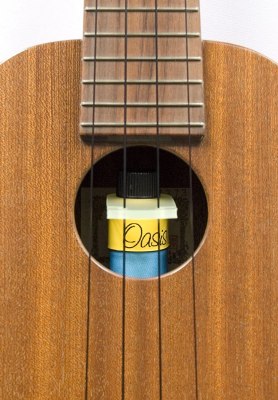Oh, The Humidity! How to Avoid Ukulele Disaster by Using Humidifiers

By Ukulele Staff
Humidity is a bugaboo of the ukulele universe. It’s this invisible force that can wreck your ukulele over time without you even being aware it’s happening. Here’s the lowdown on humidity and some tools to help control it for ukuleles.
Why You Need to Pay Attention to Humidity Around Your Ukulele
To keep it healthy and playable, a solid-wood ukulele needs to be kept somewhere between 40 and 60 percent relative humidity (RH). While laminated instruments are less vulnerable to humidity changes, they should still be cared for with the same attention.
Wood always contains moisture and it swells or shrinks as its moisture content changes.
If the humidity is high in your area, and reaches higher than 60 percent in the air where your instrument lives, the wood in your ukulele can swell. This can result in higher action, quick corrosion of your frets, and in extreme cases, loosened bridges or braces.
The vast majority of issues from humidity, however, come from excessive dryness. If the air is too dry and the humidity falls below 40 percent, the wood will shrink, causing even worse problems. For example: Cracks can appear in the wood; a top or back might sink or become separated from the sides; braces might come loose; the action might get lower and create fret buzz; frets may start protruding, causing them to become sharp, because metal does not shrink like wood; binding may pull away from the body wood.






Types of Humidifiers
Since most problems with humidity and instruments comes from a lack of humidity, most products available are made to add moisture to the air. These humidifiers come in many different shapes and sizes, but more cost under $20 and can fit in your case, or even live on the instrument itself.
But do you really need a humidifier? Well, consider that humidity goes down when you heat the air. So, if you live in an already dry climate, or if you live in an area that has you cranking the heat in winter, a humidifier is going to be essential to your uke’s health.
Advertisement
Humidifiers that fit inside your uke’s soundhole create an ideal microclimate for your little strummer. The idea behind them is simple—a moist material inside a shell helps keeps your uke near an ideal humidity—and all are simple to use and maintain. Companies that make uke-friendly humidifiers include Music Nomad, D’Addario, Kyser, and Oasis. For these type of humidifiers, you need to remoisten them with distilled water (aka DI water) every week or two, or whenever they feel or look dried out.
Another type of humidity regulator are disposable packets with two-way humidity control. These can be tossed into a case, places between the strings of an instrument at the soundhole, or used in any other way that fits your need. They come individually wrapped in plastic, and give you anywhere from two to six months, on average, of humidity control for your instrument.
A benefit of these is that you don’t have to refill them. You will know when they are used up because they will feel hard and not as flexible as when first opened. These packets are useful for traveling with your instrument. They also can act as dehumidifiers, as they offer two-way humidity control. D’Addario and Boveda make popular two-way humidity systems for your case or instrument that will add or reduce humidity as necessary.




Do You Need a Hygrometer?
How do you know if your instrument is in danger of being improperly humidified? The tool for that is called a hygrometer, which gives a digital readout of the humidity in the air, and usually the temperature as well.
Hygrometers for musical instruments range from about $20 to $40, though there are certainly options above that price point. For example, D’Addario makes a popular hygrometer and temperature sensor, and recently released a Bluetooth-enabled model that will send an alert to your phone if something’s amiss. Oasis makes a combination hygrometer and humidifier that fit in the soundhole of your instrument. Music Nomad makes a similar product that can fit in the soundhole or inside the instrument’s case.
This article was last updated in December 2022.

The Ukulele Owner’s Manual is the book that belongs in every ukulele player’s instrument case. Each chapter was written by the experts and performers at Ukulele Magazine, with topics ranging from commonsense instrument care to fixing rattles and buzzes to a pictorial history of the instrument. Book owners can also download how-to videos with step-by-step guidance on common set-up and maintenance topics.

Ukulele Basics – Learning and Practicing is a great resource for players just starting out, as well as those looking to build a more solid foundation of knowledge and skills. Get your copy today at store.ukulelemag.com.


